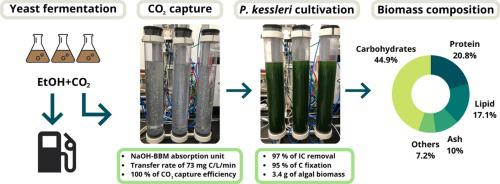Journal of CO2 Utilization ( IF 7.7 ) Pub Date : 2021-05-28 , DOI: 10.1016/j.jcou.2021.101581 Jean-Baptiste Beigbeder , Malo Sanglier , Julia Maria de Medeiros Dantas , Jean-Michel Lavoie

|
Microalgal cultivation represents a promising technique for the photosynthetic fixation of CO2 present in gas streams while offering the possibility to produce valuable microalgae-based bioproducts and biofuels. CO2 can be captured using an alkaline solution and subsequently used as an inorganic carbon (IC) source for microalgal cultivation. First, the IC removal and growth properties of P. kessleri were investigated using three synthetic NaHCO3 solutions (1, 5 and 10 g/L) with or without pH control. Results indicated that regularly adjusting the pH to 8.5 had a positive effect on the IC removal as well as on the overall microalgal proliferation. However, even if significant IC removal was achieved (> 86.4 %), only a small fraction of the carbon was directly used by P. kessleri. This phenomenon could be due to the partial loss of CO2 during carbonic anhydrase activity under the effect of constant agitation. These findings were used to design a two-step process to first capture CO2 produced during anaerobic fermentation and then convert it into fresh microalgal biomass. Fermentation of sugar-beet molasses generated around 32 g/L of ethanol while most of the CO2 was absorbed in a NaOH-BBM solution using 3.5 L photobioreactors. After P. kessleri inoculation and under low agitation, microalgae accumulated up to 44.9 % of carbohydrates in 34 days achieving 97 % of IC removal and 95 % of biofixation efficency. This study shows the potential of an integrated microalgae-based CO2 treatment process with the concomitant production of microalgal metabolites including but not limited to carbohydrates.
中文翻译:

使用Parachlorella kessleri微藻对气态发酵流出物进行CO 2捕获和无机碳同化
微藻培养代表了一种用于光合作用固定气流中存在的 CO 2的有前途的技术,同时提供了生产有价值的基于微藻的生物产品和生物燃料的可能性。CO 2可以使用碱性溶液捕获,随后用作微藻培养的无机碳 (IC) 源。首先,使用三种合成 NaHCO 3研究了P. kessleri的 IC 去除和生长特性有或没有 pH 控制的溶液(1、5 和 10 g/L)。结果表明,定期将 pH 值调整到 8.5 对 IC 去除以及整体微藻增殖具有积极影响。然而,即使实现了显着的 IC 去除(> 86.4 %),P. kessleri也仅直接使用了一小部分碳。这种现象可能是由于在不断搅拌作用下碳酸酐酶活性过程中CO 2的部分损失。这些发现用于设计一个两步法,首先捕获厌氧发酵过程中产生的CO 2,然后将其转化为新鲜的微藻生物质。甜菜糖蜜发酵产生大约 32 g/L 的乙醇,而大部分 CO 2使用 3.5 L 光生物反应器将其吸收在 NaOH-BBM 溶液中。接种P. kessleri后,在低搅拌条件下,微藻在 34 天内积累了高达 44.9% 的碳水化合物,实现了 97% 的 IC 去除率和 95% 的生物固定效率。该研究显示了基于微藻的综合 CO 2处理工艺的潜力,同时产生微藻代谢物,包括但不限于碳水化合物。



























 京公网安备 11010802027423号
京公网安备 11010802027423号